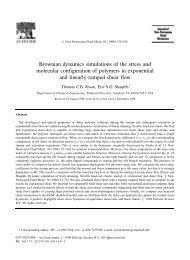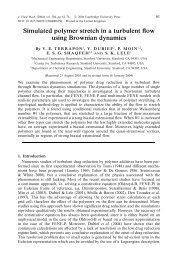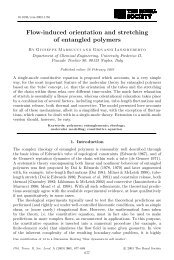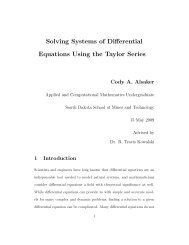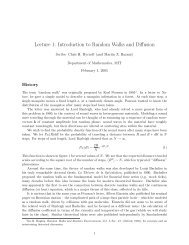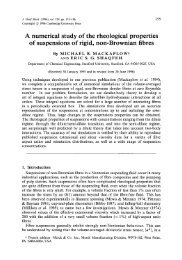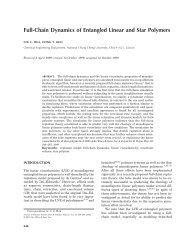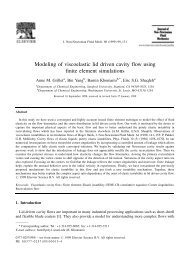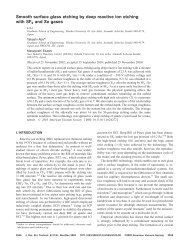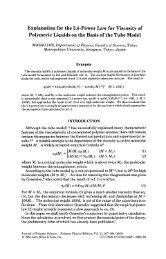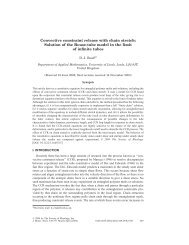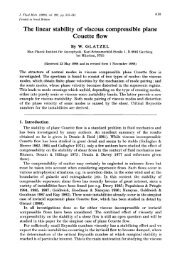Molecular modelling of entangled polymer fluids under flow The ...
Molecular modelling of entangled polymer fluids under flow The ...
Molecular modelling of entangled polymer fluids under flow The ...
You also want an ePaper? Increase the reach of your titles
YUMPU automatically turns print PDFs into web optimized ePapers that Google loves.
2.2. GAUSSIAN CHAINS 15<br />
This leads to an expression for the chain entropy, S = k B ln Ω, as a function <strong>of</strong> end to<br />
end vector.<br />
S = S 0 − 3k Br 2<br />
2Nb 2 . (2.4)<br />
Since each Kuhn segment is freely jointed there is no internal energy cost associated<br />
with any distribution <strong>of</strong> the chain. As a consequence, the chain’s free energy, F, is<br />
purely entropic.<br />
F(r) = 3k BT r 2<br />
2Nb 2 − F 0 . (2.5)<br />
This free energy is converted to a force by applying the grad operator,<br />
F(r) = − 3k BT<br />
r. (2.6)<br />
Nb2 If the chain is divided into N + 1 beads each connected by a spring then the forceextension<br />
law for each spring is<br />
F(r n ) = − 3k BT<br />
b 2 r n . (2.7)<br />
where r is the vector connecting beads n and n − 1. Thus the global properties <strong>of</strong> a<br />
Gaussian random walk are the same as a series <strong>of</strong> N + 1 beads connected by springs<br />
with spring constants given by equation 2.7.<br />
2.2.4 Rouse dynamics<br />
With the bead spring model established as valid for the static properties <strong>of</strong> <strong>polymer</strong><br />
chains it becomes natural to use the same ideas to model <strong>polymer</strong> dynamics. This model<br />
was originally proposed by Rouse (1953) and still <strong>under</strong>pins many modern theories. <strong>The</strong><br />
<strong>polymer</strong> chain is modelled as a collection <strong>of</strong> N + 1 beads connected by springs with<br />
a spring constant <strong>of</strong> 3k B T/b 2 . <strong>The</strong> drag on a bead due to the surrounding solvent is<br />
proportional to the relative velocity <strong>of</strong> the bead and its surrounding solvent, with the<br />
friction constant ζ 0 per monomer. Interactions between the beads mediated by solvent,<br />
namely hydrodynamics interactions, are neglected. Topological interactions between<br />
the chains on different parts <strong>of</strong> the same chain are also neglected. Thus the beads are<br />
not prohibited from passing through each other. This seemingly unphysical model is<br />
still valid and useful <strong>under</strong> certain conditions (see section 2.2.8 for a discussion <strong>of</strong> this).<br />
<strong>The</strong> bead positions are labelled R 0 ....R N and the force due to the nth spring is<br />
calculated using r n = R n − R n−1 . Each bead experiences forces due to: the adjoining<br />
springs, drag from its surroundings and random Brownian collisions. Thus the force



